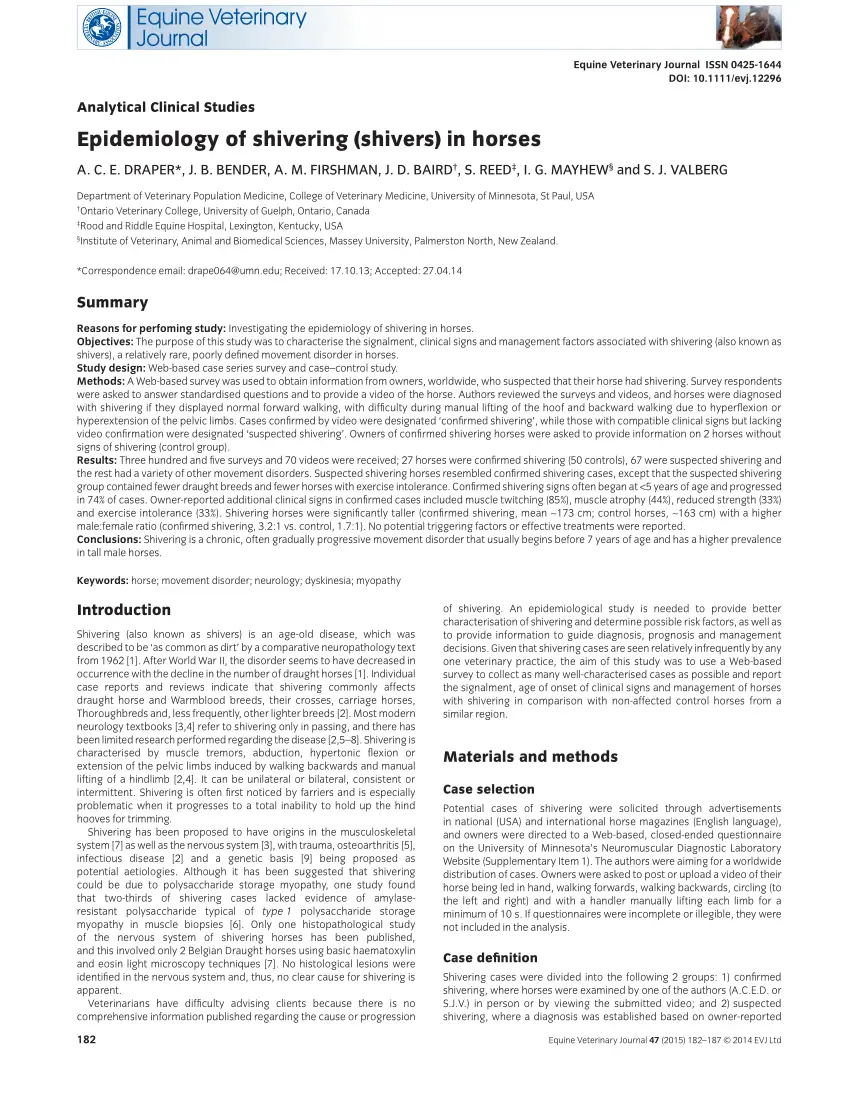Horses are magnificent creatures that have captivated humans for centuries with their grace, beauty, and power. As with any living being, horses can experience various health issues that require attention and care. One such condition that can affect horses is shivers. In this article, we will explore what shivers in horses is, its symptoms, causes, diagnosis, treatment, and management, as well as the impact it can have on horses and their owners.
What Is Shivers in Horses?

Shivers is a neuromuscular disorder that primarily affects the hind limbs of horses. It is characterized by involuntary muscle contractions, trembling, and difficulty in moving the hind limbs. These symptoms can be distressing for both the horse and the owner, and understanding the condition is crucial for proper management and care.
Symptoms of Shivers
The symptoms of shivers in horses can vary in severity and may include:
1. Involuntary Muscle Contractions
Horses with shivers often exhibit involuntary muscle contractions, particularly in the hind limbs. These contractions can cause the horse’s limbs to shake or tremble uncontrollably, leading to difficulty in movement.
2. Difficulty Picking Up the Hind Feet
Another common symptom of shivers is difficulty in picking up the hind feet. The affected horse may struggle to lift its hind limbs, leading to challenges in grooming, hoof care, and veterinary examinations.
3. Stiffness and Trembling
Shivering and stiffness in the hind limbs are also characteristic signs of shivers in horses. The affected limbs may appear tense, and the horse may experience visible trembling or shaking while standing or moving.
Causes of Shivers
The exact cause of shivers in horses is not fully understood, and it is believed to be a multifactorial condition with genetic and environmental factors playing a role. Some of the potential causes and contributing factors to shivers may include:
1. Genetic Predisposition
Certain breeds of horses, such as draft breeds and warmbloods, are more predisposed to developing shivers. Genetic factors may play a significant role in the development of the condition, and horses with a family history of shivers may be at a higher risk.
2. Neuromuscular Abnormalities
Shivers is thought to involve abnormalities in the neuromuscular system, leading to the characteristic muscle contractions and trembling. These abnormalities may be influenced by genetic factors, nutritional imbalances, or other underlying health conditions.
Diagnosis of Shivers
Diagnosing shivers in horses typically involves a thorough physical examination, neurological assessment, and possibly additional diagnostic tests such as blood work, muscle biopsies, and imaging studies. A veterinarian will evaluate the horse’s symptoms, medical history, and conduct specific tests to rule out other potential causes of similar symptoms, such as neurological disorders or musculoskeletal issues.
Treatment and Management
While there is no cure for shivers, the condition can be managed to improve the horse’s quality of life and minimize discomfort. Treatment and management strategies for shivers in horses may include:
1. Dietary Adjustments
Nutritional imbalances or deficiencies may contribute to the development or exacerbation of shivers. Adjusting the horse’s diet to ensure adequate levels of essential nutrients, such as magnesium and vitamin E, may be beneficial in managing the condition.
2. Exercise and Physical Therapy
Regular, low-impact exercise and physical therapy can help maintain muscle strength and flexibility in horses with shivers. Controlled movement and tailored exercise programs can support the horse’s overall mobility and comfort.
3. Medications and Supplements
In some cases, medications or supplements may be prescribed to alleviate muscle stiffness, reduce tremors, or manage potential pain associated with shivers. These may include muscle relaxants, anti-inflammatories, or nutritional supplements to support muscle function.
4. Environmental Management
Creating a supportive and comfortable environment for the horse is essential in managing shivers. Providing soft, non-slip footing, ample turnout time, and minimizing stressors can help reduce the impact of the condition on the horse’s daily life.
Impact of Shivers on Horses and Owners
Shivers can have a significant impact on both the affected horse and its owner. For the horse, the condition may cause discomfort, mobility challenges, and potential limitations in performance or activities. Owners may experience emotional distress, financial burdens related to veterinary care and management, and the need for ongoing support and understanding for their horse’s well-being.
If you’re curious about equine health and behavior, you might also find our articles on moon blindness in horses and fear of horses enlightening. Additionally, understanding what horses are afraid of can provide valuable insight into their behavior, so be sure to check out our piece on what horses are afraid of for more information.
Conclusion
In conclusion, shivers is a complex neuromuscular condition that can affect horses, particularly those of certain breeds. Understanding the symptoms, causes, diagnosis, treatment, and management of shivers is essential for providing the best possible care for affected horses. Working closely with a veterinarian, equine specialists, and dedicated care providers can help support horses with shivers and enhance their quality of life. By raising awareness and knowledge about shivers, we can contribute to better outcomes for horses and their owners facing this challenging condition.



